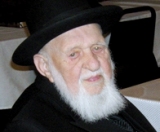 By Larry Gordon, Five Towns Jewish Times
By Larry Gordon, Five Towns Jewish Times
Sometimes you can witness history as it lives before your very eyes. On these rare occasions it can take great effort and concentration to grasp and understand that which is taking place directly in front of you. That’s the sense one gets in the presence of Rabbi Yakov Nayman, a longtime rav who resides in Lawrence, New York. Rabbi Nayman is the guest of honor at the upcoming annual dinner of Yeshiva Mir Yerushalayim, set to take place on Sunday, March 8, in New York City. It’s important to note that the bestowal of this distinction upon Rav Nayman is not exclusively due to his long and illustrious career as a pulpit rabbi, teacher, and rav-it’s much more. Rabbi Nayman, who was born in May of 1909, lived through the most tumultuous and dramatic times of modern Jewish history, and he was there when the Mirrer Yeshiva defined its place in that history, a period of time defined by faith, perseverance, and survival.
The story of survival of the yeshiva and its students at a time of international upheaval, during World War II, has become a part of our tradition attributed to the miraculous, as the yeshiva fled the Nazi onslaught. The yeshiva, with a heavy dose of Divine Providence, moved itself en masse on a journey that led it to Shanghai, a most unlikely city of refuge, to wait out the war years before moving on and spreading the study of Torah to Israel and the far reaches of the world.
(The Mirrer Yeshiva itself had been founded in 1815-twelve years after the founding of the Volozhin Yeshiva-by Rabbi Shmuel Tiktinsky, a prominent resident of the small Polish town of Mir, which is in Belarus and at times was part of the Russian Empire and the Soviet Union. After Rav Shmuel’s death, his youngest son, Rabbi Chaim Leib, was appointed rosh yeshiva. He was succeeded by his son, Rav Avrohom, who brought Rabbi Eliyahu Boruch Kamai into the yeshiva. In 1903, Rabbi Kamai’s daughter Malka married Rabbi Eliezer Yehuda Finkel, son of the legendary Rabbi Nosson Tzvi Finkel, the Alter of Slabodka, who joined the yeshiva faculty in late 1906.)
Rabbi Yakov Nayman was born and resided in Brisk and studied under the revered sage known as the Brisker Rav, HaRav Yitzchok Zev Soloveitchik, zt’l. After years of study among a chosen few in the home of the Brisker Rav and his marriage to his illustrious rebbetzin, Chaya, z’l, the young couple moved to Baranovich, where Rav Nayman studied in Yeshiva Ohel Moshe, led by HaRav Elchonon Wasserman, zt’l.
Little did the young Torah scholars or their rebbeim clearly understand how their lives would be overturned, how the winds of hatred and animosity for Jews in the prelude to World War Two would end in annihilation for millions and narrow and miraculous escapes for a few. They would be saddled for a lifetime with memories of the nightmares and would witness unfathomable destruction as well as rebirth.
I sat with Rabbi Nayman in his study recently as he was being videotaped for a presentation that will be made at the dinner, an experience that involved watching him relive the details of those days, which seemed ordinary enough in the beginning. He and his colleagues were key players in the building of Torah communities in pre-war Europe, maintaining the deep and strong tradition of Torah in Europe which can still be felt today in our yeshivas here in New York, in Israel, and around the world.
There were, of course, rumblings of the trouble to come, and probably had been for years. Hitler came to power, the Communists were determined to tighten their grip and spread their influence even as Torah in European capitals was flourishing. It’s difficult to relate to, but I’m sure most of us have our own personal account of what took place next, perhaps through a grandparent, an uncle, or a neighbor. It was a few days before Rosh Hashanah in 1939, Rav Nayman says, when Jews from neighboring locations arrived in Baranovich and, noticing the matter-of-fact calm in the Slonimer shtiebel, asked Rav Nayman and others why they weren’t running away. Weren’t they aware? Didn’t they know that the Nazi army was on the move and destroying Jewish communities in its wake?
The rabbi explains that the Germans were already in Warsaw and on the move. He and his family-seven people in all-then immediately fled Baranovich and headed for Vilna, where they arrived toward the end of the second day of Rosh Hashanah. It was a Friday afternoon, Rabbi Nayman explains, and upon his arrival he asked the first Jew that he saw to please bring him a shofar so that he could sound the tekios before Rosh Hashanah ended and Shabbos would arrive.
Though occasional bombings and low-flying planes could be heard, the days following the trek to Vilna were relatively quiet. In fact, the small group felt that things had quieted sufficiently for them to return to Baranovich for Yom Kippur. It was, however, a short-lived respite, as shortly thereafter they were once again on the move, trying to stay at least one step ahead of the German army.
In Vilna, they were joined by small groups of Jews, including the Amshinover Rebbe and a group of Chabad chassidim, as well as several hundred young men and women from the Mirrer Yeshiva also fleeing, trying to figure out if there was a way to survive the senseless onslaught. The yeshiva group, and many accompanying them from far-flung areas of Europe, eventually fled to Siberia and then to safety in Kobe, Japan. They remained in Japan until they were expelled and relocated to the Chinese city of Shanghai, which was at that time controlled by Japan.
Once they were settled in Shanghai, a question arose regarding which day of the week was actually Shabbos. The yeshiva petitioned several leading poskim, but until the day was firmly established, many in the yeshiva observed two days each week as Shabbos. Also in Shanghai, Rabbi Meir Ashkenazi, a Chabad chassid, arranged for the yeshiva to occupy the Beit Ahron shul, which had been built by Sephardic Jews in 1920.
Rabbi Nayman becomes animated when talking about the five years spent in Shanghai. He is overcome with emotion when he ponders and articulates the miracle that he was part of a group of 500 Torah students who flourished under the rubric of the Mir Yeshiva and what it still means today, all these years later, to the Torah world.
Today, the Mir Yeshiva in Eretz Yisrael, led with immense self-sacrifice by Rav Nosson Tzvi Finkel, can be the Torah base to upward of 5,000 talmidim at any given time. It is a fluid bastion of Torah scholarship and is at the pinnacle of leadership, emulated by so many other yeshivas and institutions. The Mir is now almost 200 years old. It’s strength during those trying times of World War II are what made it possible for Torah to persevere in new uncharted environments on distant shores.
After the war, Rabbi Nayman settled in Chicago, where he served as rav of a shul for nearly half a century, until he moved to the Five Towns about 18 years ago. “When I first came to Chicago,” the rav says, “we had two minyanim each Shabbos morning. At the first minyan, we had about 800 people; at the second minyan, there were only 40 or so.” He soon learned that those attending the early minyan did so in order to be able to go to work afterward, a bitter reality of early refugee life in America. Rabbi Nayman undertook as his mission to reverse that inclination and over the years had recorded remarkable success.
And it’s exciting to think that on March 8, the opportunity will present itself to pay tribute to and be in the presence of Rav Nayman, who was not only a witness to the historic journey of the Mir Yeshiva, but who played a vital role in infusing the Mir with the spirit and ability to go forward, expand, and indeed set the trend of Torah institutions in the postwar era.
It’s not just a matter of hearing the stories of a man who has acquired some expertise on some subject. To see and listen to Rav Nayman is to let him take us by the hand and walk through a history of our people, of our relatives-some here and some gone-and bring to life a past that we thought dissolved long ago somewhere into the mystery of time. It’s good to know that it is still here and, in this rabbi’s every breath, very much alive.
{Five Towns Jewish Times/Matzav.com Newscenter}












Hashem should give him Koach!
He is a national treasure
As you say, may Hashem give him Koach, which He does everyday. Thank you from Rabbi Nayman’s grandson.